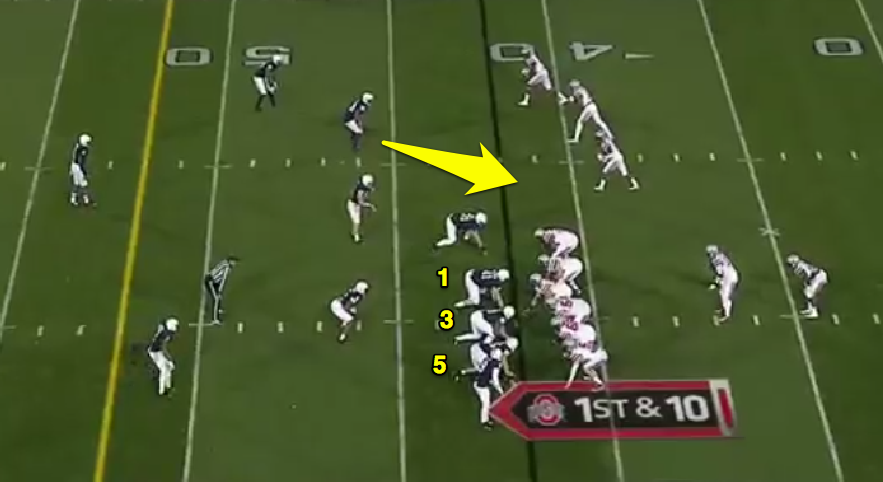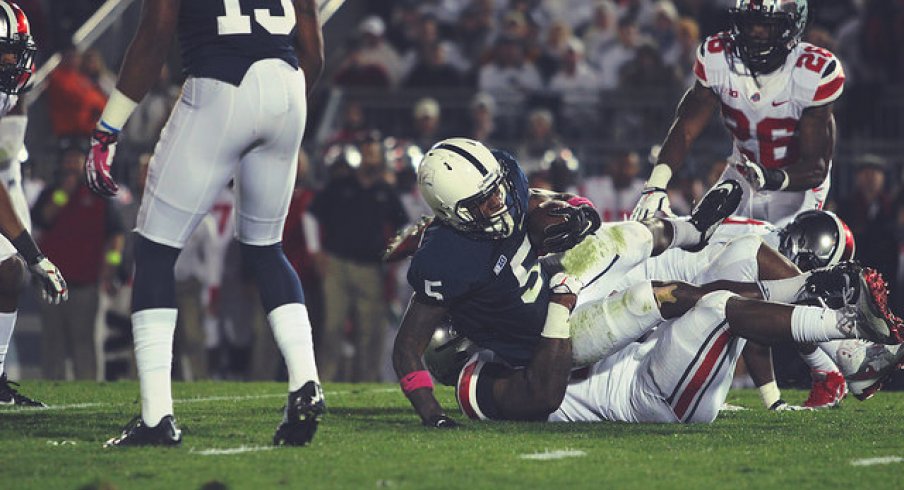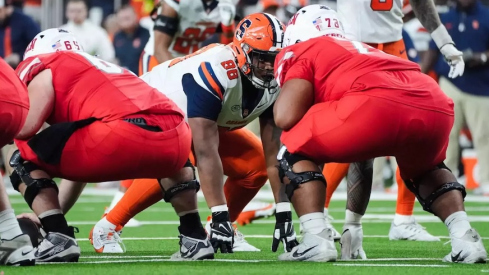That Ohio State had to sputter to a double overtime victory over Penn State was largely due to a malfunctioning passing game and an injured quarterback. JT Barrett showed his inexperience in the pocket, but he made up for those faults in overtime with timely decision-making and running.
Despite yielding a game-tying field goal in regulation, the Ohio State defense spurred the Buckeyes to victory. The defensive front controlled the line of scrimmage, and the Buckeye secondary played with sound technique and prevented big plays.
The victory showed the limits for Urban Meyer's offense with an inexperienced and injured quarterback. But it also demonstrated where the Buckeyes need to continue to develop — both in scheme and execution.
playing Sound
The Ohio State defense limited Penn State's admittedly hobbled offensive attack by preventing any Nittany Lion running game. Defensive tackles Michael Bennett and Adolphus Washington and end Joey Bosa made numerous solo tackles in the backfield by resetting the line of scrimmage and getting off blocks.
From there, the Buckeyes limited the Penn State passing game through a combination of sound cover 4 play and liberal use of zone blitz packages. Defensive coordinator Chris Ash repeatedly dialed up six-man overload zone blitzes — even on early downs. Ash would bring his front four rushers along with the walkout linebacker/nickel and inside linebacker.
Behind the rush, Ash borrowed a page from Michigan State defensive coordinator Pat Narduzzi and played a 3 deep, 2 under zone. The coverage self-evidently contains coverage holes. But the theory is that, through pressure, the defense creates a negative play or forces the quarterback to throw underneath, limiting the offense to a short gain.
The Buckeye pass rush is aided in recent weeks by the development of a second edge rusher. Bosa is a given and requires double teams (Penn State found out why on the game-clinching sack).
But walkout linebacker Darron Lee has also proven to be an explosive rusher. This provides Ash versatility. With the Buckeyes' nickel package, Ash pulls a defensive tackle. Lee bumps down and becomes either a defensive end or rover in the nickel package. The result is more available zone blitz combinations.
The Dink and Dunk
Knowing they could not sustain blocks against the Ohio State defensive line, Penn State extensively employed constraint plays. The Nittany Lions mixed wide receiver screens with the quick game and movement passing, in an attempt to change the launch point and protect quarterback Christian Hackenberg.
Although the Nittany Lions completed passes, Ohio State prevented explosive plays by remaining sound in Ash's cover 4 scheme and tackling in space. In so doing, the Buckeye back seven demonstrated their continued improvement. The Buckeye secondary were disciplined in their pattern matching reads.
For instance, Penn State repeatedly tried to fake bubble screens to throw deep, only to find receivers covered. Boundary safety Tyvis Powell's critical interception was another example of the Buckeye secondary's coverage improvement in responding to pass pattern distribution — as well as further demonstration that Powell is the anchor of the Buckeyes' secondary.
The Buckeye defense is also receiving improving play from Lee and Will linebacker Josh Perry, limiting the offense's ability to gain additional yards.
Boundary Games
But the Penn State offense came back in the fourth quarter by attacking the boundary flat — a cover 4 week spot. The Nittany Lions had a measure of success running the football wide into the boundary. In the Buckeyes' cover 4, frontside force support comes both from the walkout linebacker and safety, who have natural leverage.
But to the boundary, force comes solely from the free safety. The Will linebacker must also flow to the football, but he has to first defend his gap and then get across the offensive tackle. Both Buckeye safeties remain a step slow in coming downhill against the run. But the problem is amplified to the boundary.
Penn State exploited the boundary flat with quick outs to the slot tight end. Against two-detached receivers Ash's utilizes a two-read technique he calls Cathy, among his corner, safety, and weak-side linebacker. When the outside receiver releases vertically and the inside receiver releases to the flat, the corner and safety bracket the outside receiver while the linebacker takes the inside receiver. But Perry often could not get outside quick enough to stop the completion.
At times, Ash altered the coverage so that the safety covered the slot. And Penn State never gained more than ten yards on the play. Yet the Nittany Lions were able to inch their way down the field to tie the game — aided by a roughing the passer penalty and a dropped interception by Armani Reeves.
But as Kyle noted, the Buckeyes ended the game by freeing Bosa. Ohio State was in a bear front and Ash called a twist with an A gap blitz from Lee. Bennett slanted into the guard while the center was concerned with picking up Lee in the backside A gap. This left Bosa — aligned in a 3-technique — a free release until the running back.
Bringing Your C Game
On the opposite side, two things quickly became apparent for the Buckeye offense: Ohio State could run the football inside against Penn State's defense and Barrett was not comfortable in the passing game.
In the first half, Penn State combined a focus upon the tight zone play with a conservative secondary approach. Like teams before it, the Nittany Lions unveiled a new defensive front in an attempt to slow the Buckeye run game. The Penn State front regularly aligned in what Meyer refers to as a load front. The defense looks like it is in an over. But load places the three technique, five technique, and Sam linebacker to the strong side.
Penn State was particularly apt to align in load when the Buckeyes went to the pistol. Upon the snap the defense front would often pinch down for the inside gap, and the backside 1 technique would fight across the center's face. The backside nickel would crash down to account for the quarterback.

But the Buckeyes were able to run the football by mix and matching concepts. For instance, the focus upon tight zone left the Nittany Lions with no answer for power. By blocking down and kicking out, the offense could run outside the pinching front.
Penn State also never fully accounted for Barrett as a runner, whether on read plays or QB power. The combination of Elliot and Barrett propelled Ohio State to a 17-0 halftime lead.
Something Missing
But the Buckeye offense missed the chance to put Penn State away early. The primary culprit was several unsuccessful short yardage attempts. This is where Penn State's load front was particularly effective. Nittany Lion Defensive Coordinator Bob Shoop knew that in short yardage Ohio State first response is to go hurry-up and run tight zone from pistol. The G front with the pinch was implemented to take that play away. Yet Ohio State repeatedly insisted on running the play — to no gain.
The Buckeyes later overcame Penn State's strategy in one of two ways. OSU ran tight zone to the open side, away from the overload front. Or they used quarterback power to spread out the Nittany Lions. But by that point they had missed several opportunities.
Chicken and Egg
But Ohio State was also hamstrung by the lack of a consistent passing game. The problem had many sources and, as always, it is difficult to discern the cause and effect.
As noted, the Nittany Lion protected themselves with their aggressive front seven approach by generally playing soft secondary zone coverage. Shoop knew from film study that the Buckeyes liked throwing vertical or work the middle of the field with slant and crossing routes.
So the secondary employed a soft coverage while the inside linebackers took deep drops. To do so, Penn State had to sacrifice something, and that was leaving the underneath flats open.
Although the Buckeyes had several easy completions in the flat, they did not consistently exploit the area. For instance, Barrett completed an easy throw off sprint off on third down in the fourth quarter but the Buckeyes never again used the concept.
Penn State successfully mixed and matched their blitzes. The Nittany Lions did not bring numerous rushers. But they frequently brought their nickel off the edge, particularly to the Buckeye right side, which seemed to bother Barrett's timing.
Penn State also scouted well. For instance, Shoop called a well-timed zone blitz on Penn State's pick 6. The Nittany Lions knew that the Buckeyes like running double slants in that situation from an empty backfield. The Penn State defensive tackle faked a rush and then dropped right into the slant passing lane.
Interior linemen Jacoby Boren, Billy Price and Pat Elflein had occasional struggles. Price in particular has been inconsistent pass blocking. But while they were not perfect, the Buckeye offensive line largely managed the Nittany Lion pressure.
But while these were all issues, the primary cause of the passing game's struggles were the struggles of Barrett. He was skittish in the pocket and was hesitant to throw the football, often double clutching and throwing late. Multiple Penn State pressures and sacks were a result of him holding the football too long.
No better example of the Buckeye passing game struggles came on the third quarter drive that resulted in a missed field goal. The Buckeyes had three runs of 10 yards or more to put them in scoring position and then had two open opportunities off play action to Michael Thomas and Devin Smith. But on both Barrett threw late and to the inside, nearly leading to an interception.
Barrett's relative lack of arm strength means that he has to throw such routes on time — he cannot hold the ball and still beat a safety coming across the field.
Then on third down from the Penn State 23, offensive coordinator Tom Herman dialed up the flat route to tight end Jeff Heuerman that was open all game. But while Heuerman was wide open, Barrett triple pumped, allowing the defensive end to bat down the football. When your quarterback is struggling it is difficult to continuing throwing — particularly with a lead.
Adding Up
But the Buckeyes' passing game troubles would not have necessarily been debilitating if it were not combined with Barrett's sprained knee that limited him as a runner.
The focus is often upon Meyer's spread formations. But the purpose of spreading out is to run the football — particularly by using the quarterback as a run threat to change the arithmetic. Meyer's offense does not function the same without that threat.
With Barrett not attempting to run the Buckeyes lost this advantage. Several times in the fourth quarter Barrett handed off for negative yardage — when he would have gained chunk yardage by keeping. For instance on this 13 bash play, Penn State middle linebacker Mike Hull has turned his back to pursue Ezekiel Elliot. If Barrett keeps it results in chunk yardage. Instead it is a loss of six.
Tom Herman and Meyer attempted to overcome this impediment by direct snapping to H receivers Dontre Wilson and Jalin Marshall, but to moderate success. Without a passing game or a running quarterback, Penn State brought down a safety and could clamp down on the Buckeye run game.
Pulling it Together
Going forward, the Buckeye coaching staff must expect different looks aimed to stop tight zone. Ohio State is so efficient with its base offense that teams seek different ways to stop the inside run game and vertical passing game.
So Herman and Meyer must be prepared to adapt. One way to do so is exploit the underneath flats if teams are surrendering this yardage. As noted, when the Buckeyes did pass they could have relied more heavily on quick hitches, sprint outs, pop passes, and flat routes. Perhaps this would have settled Barrett down by reducing Barrett's reads and get him out of the pocket. Such plays were used — but not consistently.
So the Buckeye coaching staff was in the unenviable position of having a malfunctioning passing game. Penn State only got back in the game with the two interceptions. So it likely made sense to play more conservatively.
And in fact, the opposite may have been true Saturday — that the Buckeyes hurt themselves by not sticking with the inside run game more consistently. As noted, Penn State never stopped the Buckeye run game except for overloading against the strong-side tight zone play in short yard. Yet on several drives in the second half the Buckeyes gained first downs by running — only to see those drives stall by inefficiency in the passing game. When a passing game is not producing positive yards a team should continue running the football.
This was evidenced in overtime. Once Herman and Meyer could re-apply Barrett in the run game, the Buckeyes moved the football with relative ease. The Buckeyes used the aggressiveness of Penn State's load front against them. And the Nittany Lions did not appear prepared for Barrett to keep again.
On the first touchdown drive Barrett ran for 17 yards by pulling the football and keeping around the pinching defensive end. Then on his touchdown run the Buckeyes returned to running tight zone away from the tight end. This allowed Barrett to read the pinching 5 technique while the tight end fan blocked the outside linebacker.
Barrett deserves a lot of credit. After a rough outing he did an excellent job in overtime with his decision-making and ball handling. And he ran very hard with a sprained knee.
But self-evidently, such uneven offensive performances cannot continue. Barrett must play better — as does the Buckeye interior in pass blocking. The Buckeye coaching staff needs to be readily prepared for teams focusing on stopping tight zone and play-action vertical routes.
Ohio State also needs bigger contributions from their skill position players. Scoring is directly correlated to explosive plays. Yet the Buckeyes only had one play over 20 yards -- a run by Barrett. While Barrett missed several deep passing opportunities, Ohio State also needs players like Elliot, Wilson, and Marshall who are getting the football near the line of scrimmage to break big plays.
But an uneven performance was still a win in a hostile road environment. Ohio State faces another such environment November 8 against a much better opponent in Michigan State. Ohio State would likely not be prepared for that situation without its experience in Happy Valley. And it is an important building block for an improving defense to lead the Buckeyes to victory. Yet the performance also shows where Ohio State must improve — and how far they need to go. This week against Illinois look for the Buckeyes to attempt to throw early and often to in an attempt to get the passing game back on track.


